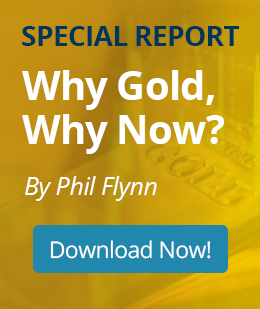Phil Flynn
Phil Flynn is writer of The Energy Report, a daily market commentary discussing oil, the Middle East, American government, economics, and their effects on the world's energies markets, as well as other commodity markets. Contact Mr. Flynn at (888) 264-5665
Translate





Platinum Complex Breakout & Russia Sanctions Shake-Up! Manic Metals Report 07/21/2025
The metals market is surging by reversing Sunday night opening weakness and resistance.
We are diving headfirst into the molten core of what’s driving this mania. Central banks are stacking gold like it’s the last pizza at a buffet, platinum is eyeing a historic breakout, and Russia sanctions are throwing a Molotov cocktail into the platinum group metals (PGM) supply chain.
So, the European Union has just signed off on its eighteenth round of sanctions against Russia for the Ukraine conflict—yes, eighteenth—this time supposedly tightening the screws on the Russian oil and energy sectors and still clinging to the notion that oil price caps will make a difference. The latest brainchild? Yet another “improved” price cap on oil. One can’t help but wonder: if seventeen rounds of measures haven’t done the trick, is an eighteenth really going to move the needle?
The EU will set a moving price cap on Russian crude at 15% below its average market price, EU diplomats said, aiming to improve on a largely ineffective $60 cap that the Group of Seven major economies have tried to impose since December 2022.
Yet regardless because Russia is a major plus producer of platinum and Palladium its going s gonna be a wild ride through the world of industrial and precious metals!
Let’s kick this off with the shiny yellow metal—gold! Gold seems to be getting support from the August 1st trade deadline as the dollar has shown some weakness.
Bloomberg reported ‘gold rose as traders assessed differing views from US Federal Reserve officials on how President Donald Trump’s tariff agenda will impact inflation. The precious metal was up as much as 0.6% to near $3,370 an ounce after Fed Governor Christopher Waller advocated for a rate cut last week and Governor Michelle Bowman also expressed an openness to a reduction. Meanwhile, their colleagues remained more cautious due to the risk of persistent inflation triggered by tariffs. Lower borrowing costs tend to benefit gold as it doesn’t pay interest.
But let’s face it the reason why gold is really strong is because Central banks worldwide are hoarding gold like it’s the key to surviving a financial apocalypse.
Since Russia’s invasion of Ukraine in 2022 and the G7’s sanction sledgehammer froze $300 billion of Moscow’s assets, central banks from Beijing to Tehran are stacking gold bars faster than you can say “geopolitical chaos.”
Why? Because gold is the ultimate hedge against sanctions, inflation, and global uncertainty.
Russia’s Ministry of Finance doubled its National Wealth Fund gold allocation to 40% in 2021, and with prices hitting $3,500/oz in April 2025, their reserves ballooned by $96 billion—offsetting a third of those frozen assets.
The market’s buzzing with rumors of more central bank buying, especially from BRICS nations looking to dodge the U.S. dollar’s grip.
Russia’s pushing a gold-backed BRICS currency, and if that gains traction, we could see gold rocket past $3,000 again. Keep your eyes peeled—this metal’s got rocket fuel in its veins!
Now, let’s talk platinum, the underdog ready to steal the spotlight as it has had what can only be described as a mega breakout. At least that is what posts on X are saying screaming about a “mega breakout” in platinum, and they’re not wrong.
Platinum’s sitting right below a massive resistance level, and the charts are looking bullish.
Priced at $1,044/oz today, platinum’s up from its August low of $900, and the momentum’s building.
Why the surge? It’s a perfect storm: central bank buying, supply fears, and automakers swapping palladium for platinum faster than you can swap out a spark plug.
Russia, which supplies 10% of global platinum, is under fresh sanction pressure. The U.S. is pushing G7 allies to clamp down on Russian metals, and while platinum’s not directly targeted yet, the fear of supply disruptions is lighting a fire under prices.
Add to that the World Platinum Investment Council’s (WPIC) report of a 627,000 oz surplus in 2022 flipping to tighter supply-demand dynamics in 2025, and you’ve got a recipe for a breakout.
Auto demand’s up 16% as stricter emissions rules and palladium substitution kick in. If platinum smashes through that resistance, we could see $1,200/oz before you can say “catalytic converter”.
Palladium prices surged nearly 10% on October 24, 2024, reaching $1,200/oz—the highest since December 2023—before settling at $1,119.88/oz.
The market remains volatile as Russia’s Nornickel, which produces 40% of global palladium, faces potential G7 sanctions prompted by the Biden administration targeting Russian palladium and titanium.
The U.S. is already facing a palladium shortage, as Sibanye-Stillwater plans to cut production at its Montana mine next year. The Trump Administration is doing everything they can to ramp up the production of industrial metals.
South Africa can’t fill the gap, and recycling’s not cutting it. Back in 2022, when the UK slapped a 35% tariff on Russian PGMs, palladium jumped 30% in five days!
If these new sanctions hit, we could see palladium soar past $1,500/oz. But here’s the kicker: Nornickel’s redirecting sales to China, which is snapping up Russian metal like it’s Black Friday. This could keep some supply flowing, but the West’s gonna feel the pinch.
Russia Sanctions are the geopolitical wildcard. Russia has demonstrated significant resilience in navigating international sanctions, leveraging resources such as gold and platinum group metals (PGMs) to support its financial stability. The 2022 LPPM ban on newly refined Russian platinum and palladium disrupted global markets; however, producers like Nornickel continued to supply manufacturers.
With the United States and United Kingdom implementing further restrictions—including the prohibition of Russian base metals like aluminum, copper, and nickel from trading on the LME and CME in April 2024—PGM markets are experiencing increased uncertainty.
While these measures do not completely halt Russian metal exports (as markets in China and India remain receptive), they have notably constrained Western supply chains.
The BRICS summit in October 2024 intensified market dynamics, with Russia proposing the establishment of a precious metals exchange aimed at circumventing Western trading platforms. Should this initiative succeed, it could fundamentally alter global PGM pricing structures and impact London’s role as a major trading center. In response, automotive manufacturers are mitigating risks by substituting palladium with more cost-effective platinum, a strategy that may limit palladium price growth while substantially boosting demand for platinum.
Make sure that you sign up for the Phil Flynn daily energy report as well as the daily trade levels you also need to open your trading account by calling me today at 888-264-5665 or you can e-mail me at pflynn@pricegroup.com. Also make sure you stay tuned to the Fox Business Network because they are invested in you.
Phil Flynn
Senior Market Analyst & Author of The Energy Report and Manic Metals Report
Contributor to FOX Business Network
2918 S. Wentworth Ave., FL 1, Chicago, Illinois 60616
312 264 4364 (Direct) | 888 264 5665 (Direct) | 800 769 7021 (Main) | 312 264 4303 (Fax)
www.pricegroup.com
Please do not leave any instructions for orders in your message, as we cannot execute instructions left through email or voicemail. Orders must be entered via direct verbal communication with a representative of our firm. We cannot be held responsible for orders left in any other manner. PAST RESULTS ARE NOT NECESSARILY INDICATIVE OF FUTURE RESULTS. Investing in futures can involve substantial risk & is not for everyone. Trading foreign exchange also involves a high degree of risk. The leverage created by trading on margin can work against you as well as for you, and losses can exceed your entire investment. Before opening an account and trading, you should seek advice from your advisors as appropriate to ensure that you understand the risks and can withstand the losses. Member NIBA, NFA.
Questions? Ask Phil Flynn today at 312-264-4364